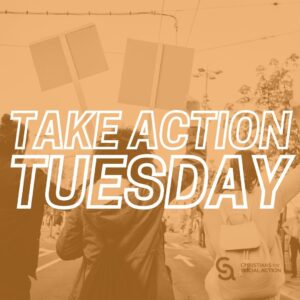Editor’s note: This piece is part 4 of our 4-part series on the levels of strategy for nonviolent direct action for racial justice. Click here to start at the beginning.
A political miracle for racial justice occurred in Birmingham, Alabama, in the late spring of 1963. The Jim Crow system buckled under the pressure of a month-long nonviolent uprising led by Black clergy.
system buckled under the pressure of a month-long nonviolent uprising led by Black clergy.
The campaign enlisted a diverse array of community members—even children—to boycott local businesses and perform street marches, sit-ins at segregated lunch counters, kneel-ins at churches, and a host of other nonviolent tactics until the Birmingham jails were too full to hold more protesters.
On May 10, Rev. Fred Shuttlesworth and Dr. Martin Luther King, Jr. announced victory. The City of Birmingham agreed to desegregate all businesses and public facilities within 90 days and to end race discrimination in hiring. Not only that, the win in Birmingham set the stage for the March on Washington later that year. It also paved the way for the passing of the 1964 Civil Rights Act, which barred discrimination in voting, business, public facilities, and education.
The Birmingham victory is consistent with the civil resistance research showing that the deployment of a diverse set of tactics is often a key factor for movement success. Keep reading to understand how your racial justice movement can design effective tactics to achieve your goals.
What Are Tactics?
Tactics are specific actions implemented to advance your movement toward your goals. Some examples of tactics include:
- marches
- boycotts
- pickets
- rallies
- strikes
Ideally, the tactics you choose are part of a larger strategy for change. They are a stepping stone toward the vision of tomorrow you developed as part of your grand strategy.
If you’ve not developed a vision of tomorrow or a grand strategy for your movement, we recommend that you refer to the beginning of this series to get the full strategic framework and increase the potential effectiveness of your tactical planning.
Understanding Objective Categories
Well-chosen tactics make the difference between success and failure in nonviolent direct action. Don’t be fooled by thinking a tactic is well-chosen because it’s edgy, big, or exciting. A tactic is well-chosen if it matches your objectives.
Objectives in nonviolent struggle are often placed in one of two categories. There are expressive goals and instrumental goals. As implied in the name, expressive goals have to do with expressing a grievance or idea. An example of an expressive goal is a march to voice outrage about local police killing an unarmed civilian. Instrumental goals refer to concrete changes: like passing a law to end segregation.
Understanding how objectives are often categorized in nonviolent struggle can help you narrow down which tactics will serve you best.
Understanding Tactical Categories
The world of tactics is more vast than most people know. There are as many tactics for social progress as there are people to imagine them. But some tactics are not well-suited to reach your goals or suitable to escalate your cause. Understanding tactical categories can help you choose tactics that best correspond to your goals.
Civil resistance scholar Gene Sharp—known as the Machiavelli of nonviolence—organizes 198 nonviolent tactics into three categories:
- Protest and persuasion tactics aim to raise awareness about an issue or express a grievance through actions like letter-writing, marches, public vigils, rallies, and speeches. Tactics in this category can be great for recruiting new activists, showing the movement’s strength, and shifting public opinion.
- Noncooperation tactics starve oppressive institutions and actors of the usual level of public cooperation they need to function. This includes tactics like boycotts and strikes. These forms of noncooperation can be social, economic, and/or political: some examples respectively include a mass exodus from oppressive religious denominations, mass calling in sick to an oppressive workplace, and defying unjust laws. Noncooperation tactics usually require large numbers of participants.
- Direct intervention tactics aim to directly disrupt. This includes tactics like sit-ins and occupations. These types of tactics can involve as few as one person. For example, Swedish activist Elin Erson temporarily halted a deportation by refusing to take her seat on the airplane.
The Advantage of Tactical Innovation
As we’ve mentioned before in this series, nonviolence is understood as a form of combat without weapons. Drawing from military history, activist Micah White reveals that in asymmetrical conflicts since 1950, the weaker party has won more often than lost [1]. He credits this phenomenon to innovation. “If the weaker refuses to mimic the stronger adversary’s actions, they win 63 percent of the time. In essence, if we innovate, we win [2].”
The same is true in nonviolent struggle. When we innovate new tactics, the oppressive forces need to analyze and come up with a plan of repression that won’t undermine their legitimacy or spark more unrest. In an ideal situation, your movement would be on to the next tactic while your opponent is still trying to figure out how to respond to the last one.
In his classic treatise The Book of Five Rings, Miyamoto Musashi explains that a proven path to victory lies in knocking your opponent off-balance [3]. In nonviolent action, we do this by implementing a diverse array of tactics, innovating new tactics, and keeping up the momentum.
The Advantage of Tactical Diversity
As mentioned before, a diversity of nonviolent tactics is a hallmark of successful movements. “Tactical diversity and innovation enhance the ability of nonviolent resistance to strategically outmaneuver the adversary [4].” Tactical diversity also allows the movement to pivot to alternative action plans when certain courses of action succumb to repression.
For example, if the only thing you’ve planned is a mass sit-in at city hall, you’ll have to take time to regroup when the police break up the occupation, because you’re not prepared to do anything else. In that lull of momentum, people go home. They join other causes. You lose momentum. You end up starting over from scratch.
In a decentralized movement with many different actors, tactical diversity can put pressure on the oppressive system on multiple fronts, overwhelming its resources.
For example, the Birmingham Campaign was not the only Civil Rights uprising that pressured the Federal government to pass racial justice legislation. The Congress of Racial Equality (CORE) had launched civil disobedience campaigns in the early 1960s; the Student Nonviolent Coordinating Committee (SNCC) was organizing a controversial integrated voter registration campaign in Mississippi in 1964; and the National Association for the Advancement of Colored People (NAACP) had been advancing legal strategy for racial progress for decades. The Jim Crow system was under attack on many fronts.
We also would do well to put the oppressive system on the defensive from multiple fronts.
The Importance of Dilemma Actions
If your tactics don’t compel your opponent to move, you don’t have a movement. This is where dilemma actions come in. Dilemma actions are the holy grail of planning nonviolent civil disobedience, because they create a situation where “your target is forced to make a decision, and all their available options play to your advantage [5].”
The Birmingham sit-ins are an example of a dilemma action. If the authorities allowed the protestors to sit there—against the racist norms of Jim Crow apartheid—it would set an undesirable precedent that could weaken the racial order. But they also knew that attacking the protestors would create bad press that could be leveraged by the Civil Rights movement to advance their cause. Furthermore, the movement leaders planned in advance to overwhelm the jails so that even arrest would serve their goals.
6 Crucial Considerations for Designing Racial Justice Tactics
Movement planners would do well to take several things into consideration when choosing tactics. Tactics chosen in haste or just because they’re familiar are sure to be less effective than tactics that consider the following concerns:
- Objective—What is the desired outcome of this tactic? If it is expressive, what is the intended message? If it’s instrumental, what specific goal is desired, and how is that decision made?
- Audience & message—You would do well to spend time developing specific campaign messages their actions are intended to communicate. You should also consider how you’ll counter the narratives your opponents are using to discredit your movement.
- Cost-benefit analysis—Discuss the potential consequences of your actions and weigh them against your potential gains. If the costs outweigh the benefits, reconsider.
-
- Targets—Who will you need to direct your actions toward to achieve your goals? What are their values? What are their political positions? Who are their supporters? The answers to questions like these will help you choose tactics that are more likely to be effective with your target.
- Timing—When are these actions likely to have maximum impact? For example, the Birmingham campaign was planned for the Easter season because that was the peak shopping season.
- Points intervention—Where does it make the most sense for you to perform these actions? The Civil Rights leaders wanted to disrupt business in Birmingham, so they chose local stores.
There is no predictable formula for social progress, but the principles described above for choosing tactics are certain to increase the chances of success.
***
This concludes our series on the levels of strategy for nonviolent direct action. If you found this series helpful, sign up for our weekly newsletter to make sure you never miss a post.
Works Cited
- White, M. (2017). The End of Protest: A New Playbook for Revolution. Vintage Canada.
- Ibid
- Musashi, M (2018). The Book of Five Rings. Shambala.
- Chenoweth, Erica, and Maria J. Stephan. Why Civil Resistance Works: The Strategic Logic of Nonviolent Conflict. Columbia University Press, 2013.
- Boyd, Andrew, and Dave Oswald Mitchell. Beautiful Trouble: A Toolbox for Revolution. OR Books, 2016.


